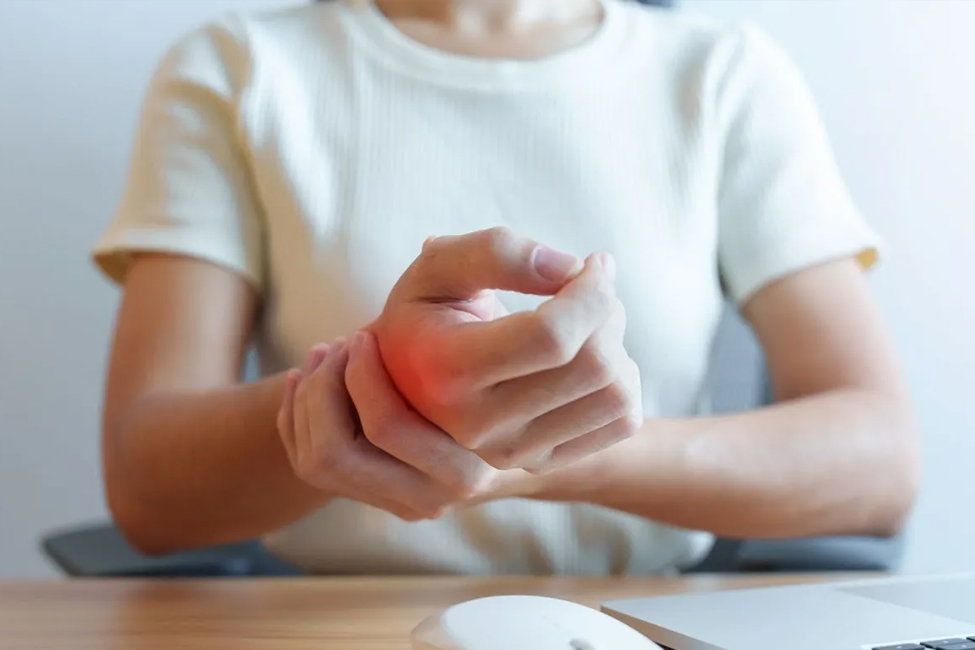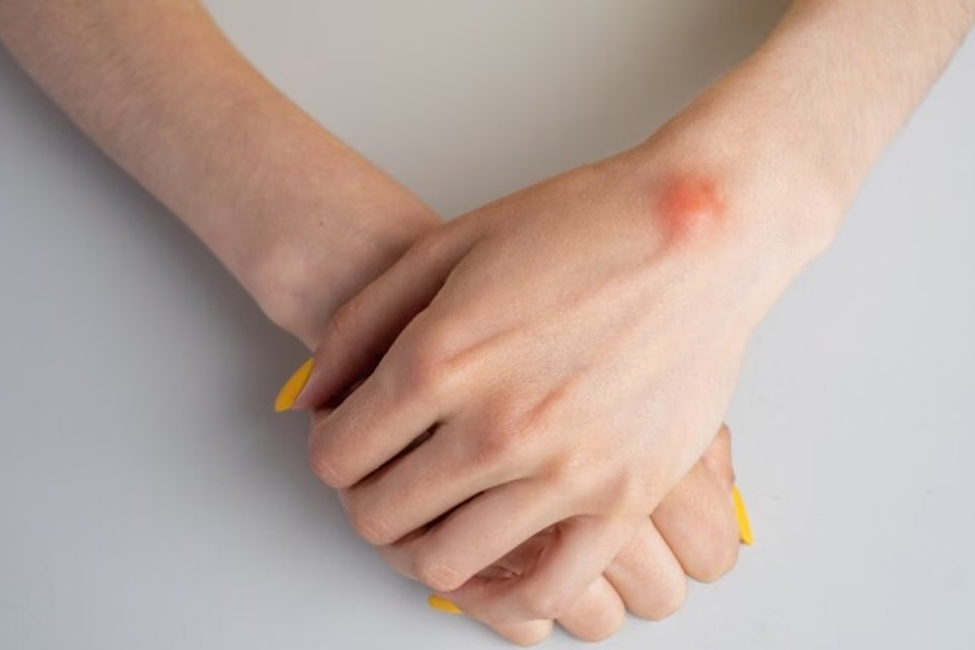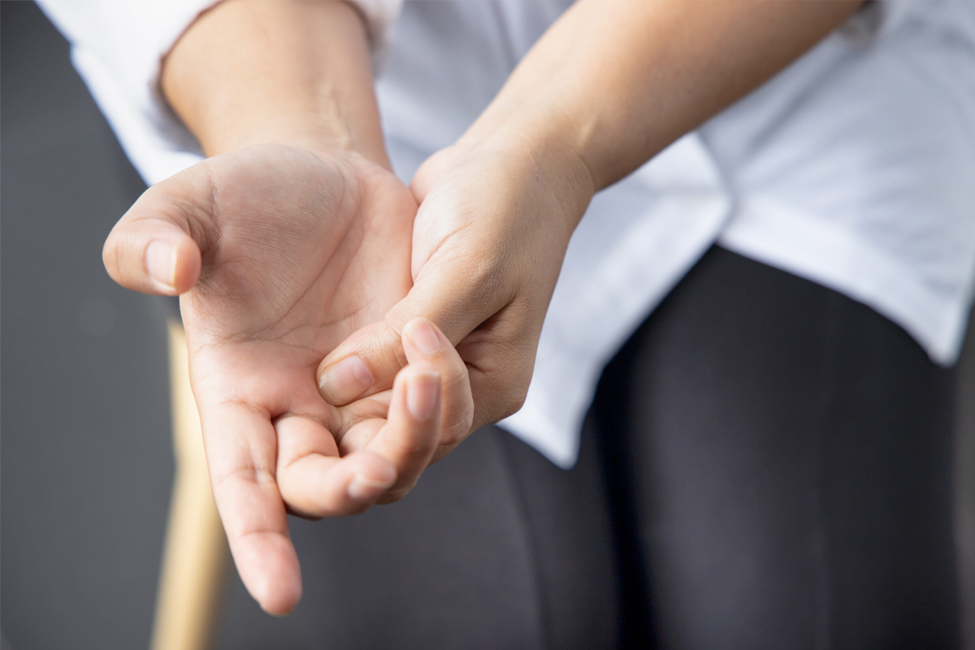De Quervain’s tenosynovitis is a painful condition that affects the tendons on the thumb side of the wrist. It involves inflammation of the sheath surrounding two specific tendons, namely the abductor pollicis longus and the extensor pollicis brevis.
Description of the Inflammation of the Sheath:
This inflammation can result in swelling and irritation, leading to pain and discomfort, particularly during thumb and wrist movement. The condition is named after the Swiss surgeon Fritz de Quervain, who first described it in the early 20th century.
Anatomy of the Wrist and Thumb
The hand and wrist comprise a complex network of bones, ligaments, tendons, and muscles. Key structures include the carpals (wrist bones), metacarpals (hand bones), and the phalanges (finger bones). Tendons are fibrous tissues that connect muscles to bones, allowing for movement. Tendon sheaths, protective coverings, surround certain tendons, facilitating smooth movement.
The thumb and wrist play integral roles in various daily activities, from gripping and grasping to fine motor tasks. Normal functioning relies on the coordinated movement of muscles and tendons, providing both strength and precision in hand movements.
Role of Tendons in Hand Movement:
Explanation of How Tendons Facilitate Thumb and Wrist Motion
Tendons act as connectors between muscles and bones. Tons in the thumb and wrist enable a range of motions, including flexion, extension, abduction, and adduction. The tendons associated with De Quervain’s tenosynovitis—the abductor pollicis longus and extensor pollicis brevis—are responsible for moving the thumb away from the hand and extending it.
Smooth gliding of tendons within their sheaths is crucial for fluid hand movement. Tendon sheaths provide lubrication and reduce friction, allowing tendons to move seamlessly during muscle contractions and relaxations. In De Quervain’s tenosynovitis, inflammation of the tendon sheath can disrupt this smooth gliding, leading to pain and discomfort during thumb and wrist movements.
Causes and Risk Factors of De Quervain's Tenosynovitis
De Quervain’s tenosynovitis is a condition characterised by inflammation of the tendons at the base of the thumb, leading to pain and swelling in the wrist. Understanding this condition’s causes and risk factors is essential for prevention and effective management.
Repetitive Hand and Wrist Movements
Engaging in repetitive hand and wrist movements, especially those involving grasping, twisting, or pinching, can strain the tendons and contribute to inflammation.
Overuse of Thumb
Activities that involve repeated and forceful use of the thumb, such as texting, gaming, or extensive writing, can contribute to the development of De Quervain’s tenosynovitis.
Inflammatory Conditions
Underlying inflammatory conditions, such as rheumatoid arthritis, can increase the likelihood of tenosynovitis by triggering inflammation in the tendon sheaths.
Direct Trauma or Injury
A direct injury to the wrist or thumb, such as a fall or impact, can damage the tendons and lead to inflammation.
Risk Factors
- Age and Gender – De Quervain’s tenosynovitis is more common in individuals between the ages of 30 and 50. Women are also at a higher risk, especially those who are pregnant or have recently given birth.
- Occupational Factors – Occupations or activities that involve repetitive hand and wrist movements, such as typing, knitting, or using tools, increase the risk of developing tenosynovitis.
Anatomical Factors – Anatomic variations, such as a thickening or swelling of the tendons, can predispose individuals to De Quervain’s tenosynovitis. - Postpartum Period – The hormonal changes that occur during pregnancy and the postpartum period can contribute to increased fluid retention and swelling of the tendons, making women more susceptible.
- Inflammatory Arthritis – Individuals with inflammatory arthritis, such as rheumatoid arthritis, have an elevated risk of developing tenosynovitis due to systemic inflammation affecting the joints and tendons.
- Obesity – Excess body weight can increase the strain on the tendons in the wrist and thumb, contributing to inflammation.
Symptoms of De Quervain's Tenosynovitis
De Quervain’s tenosynovitis is characterised by distinct symptoms that impact the wrist and thumb, often causing discomfort and hindering normal hand movements.
Pain and Tenderness
Individuals with De Quervain’s tenosynovitis typically experience pain localised on the thumb side of the wrist, particularly near the base of the thumb. Tenderness is commonly felt along the path of the affected tendons, which can be identified through palpation by a healthcare professional.
Swelling and Inflammation
The affected area often exhibits visible swelling, particularly near the base of the thumb. Inflammation may manifest as increased warmth and redness in the affected region, indicating an inflammatory response.
Difficulty Moving the Thumb
Individuals may experience a restricted range of motion, particularly when engaging in activities that require thumb and wrist movement. Difficulty gripping or pinching objects is a common symptom, reflecting the impact of the inflammation on the tendons’ ability to glide smoothly.
Diagnosis of De Quervain's Tenosynovitis
Accurate diagnosis of De Quervain’s tenosynovitis involves a combination of clinical examination and imaging studies, enabling healthcare professionals to identify specific symptoms and rule out other potential causes.
Clinical Examination
A healthcare professional, often a hand specialist, conducts a thorough physical examination to assess hand and wrist movements. Specific attention is given to the affected thumb side of the wrist to identify signs of pain, tenderness, and limited range of motion.
The Finkelstein test is a key diagnostic manoeuvre where the patient makes a fist with the thumb enclosed within the fingers, and the wrist is bent toward the little finger. Pain along the thumb side of the wrist during this manoeuvre is indicative of De Quervain’s tenosynovitis.
Imaging Studies
X-rays may be performed to rule out other potential causes of wrist pain, such as arthritis or fractures. While De Quervain’s tenosynovitis primarily involves soft tissues, X-rays help comprehensively evaluate the wrist and surrounding structures.
More detailed imaging studies, such as ultrasonography or magnetic resonance imaging (MRI), are employed to visualise the soft tissues, including tendons and sheaths. These studies confirm the presence of inflammation in the tendons and help assess the severity of the condition.
Treatment Options for De Quervain's Tenosynovitis
De Quervain’s tenosynovitis can be effectively managed through a range of treatment options, including conservative measures, corticosteroid injections, and surgical interventions, depending on the severity and persistence of symptoms.
Conservative Treatments
Rest and Immobilization
- Rest is crucial to allow the inflamed tendons to heal. Individuals are advised to avoid activities that worsen symptoms, such as repetitive thumb and wrist movements.
- Immobilisation through splints or braces helps reduce strain on the affected tendons, promoting a healing environment.
Ice and Anti-Inflammatory Medications
- Ice packs can be applied to the affected area to alleviate swelling and relieve pain.
- Nonsteroidal Anti-Inflammatory Drugs (NSAIDs) such as ibuprofen, are commonly recommended to reduce pain and inflammation associated with tenosynovitis.
Physical Therapy
- Physical therapy includes targeted exercises to strengthen the muscles around the thumb and wrist, enhancing overall function.
- Therapists may employ techniques to improve joint mobility and reduce stiffness in the affected area.
Corticosteroid Injections
Corticosteroid injections are administered directly into the tendon sheath to reduce inflammation and alleviate symptoms. This approach is often effective in providing short-term relief for individuals with persistent symptoms.
Surgical Options
Surgical intervention involves releasing the constricted tendon sheath through an open incision or an endoscopic procedure.
When conservative measures and injections do not provide sufficient relief, surgical release becomes a viable option, especially for persistent or severe cases of tenosynovitis.
Recovery and Rehabilitation
Recovery and rehabilitation for De Quervain’s tenosynovitis involve a tailored approach depending on the chosen treatment. For those opting for conservative measures, a gradual return to activities and ongoing physical therapy is emphasised to enhance strength and flexibility.
Corticosteroid injections may require post-injection monitoring, while surgical intervention involves protective measures initially, followed by a phased reintroduction of activities and post-surgery physical therapy. Regardless of the treatment path, individuals are encouraged to communicate openly with healthcare providers, adhere to recommended guidelines, and incorporate self-care strategies to support a successful recovery, prevent recurrence, and optimise hand and wrist function.
Regular follow-up appointments are crucial in assessing progress and making necessary adjustments to the rehabilitation plan.
Prevention
Preventing De Quervain’s tenosynovitis involves proactive measures of modifying hand movements and incorporating exercises into daily routines to maintain hand health.
Awareness of Hand and Wrist Positioning during Activities
Individuals are advised to be mindful of hand and wrist positioning during various activities, particularly those involving repetitive thumb and wrist movements. Maintaining a neutral wrist position can help reduce strain on the tendons.
Techniques to Minimize Stress on the Thumb Tendons
Techniques such as avoiding excessive force, minimising repetitive pinching or gripping, and taking breaks during activities that strain the thumb tendons prevent tenosynovitis.
Incorporation of Thumb and Wrist Exercises into Daily Routines
Regularly incorporating specific stretching and strengthening exercises for the thumb and wrist into daily routines helps maintain flexibility and strengthen supporting muscles.
Maintenance of Hand Health through Regular Conditioning
Consistent conditioning of the hands through exercises, including thumb opposition movements and gentle stretches, promotes overall hand health and resilience against conditions like tenosynovitis.
Importance Of Early Diagnosis And Intervention
Early diagnosis and intervention are crucial in managing De Quervain’s tenosynovitis. Swift recognition of symptoms allows timely implementation of conservative measures, preventing progression and minimising complications. attention upon symptom onset is essential for optimal outcomes.
Early care alleviates symptoms effectively and reduces the risk of long-term damage, functional limitations, and chronic inflammation, positively impacting overall quality of life and lessening the economic burden associated with prolonged treatment. Seeking prompt medical attention upon symptom onset is essential for optimal outcomes.









